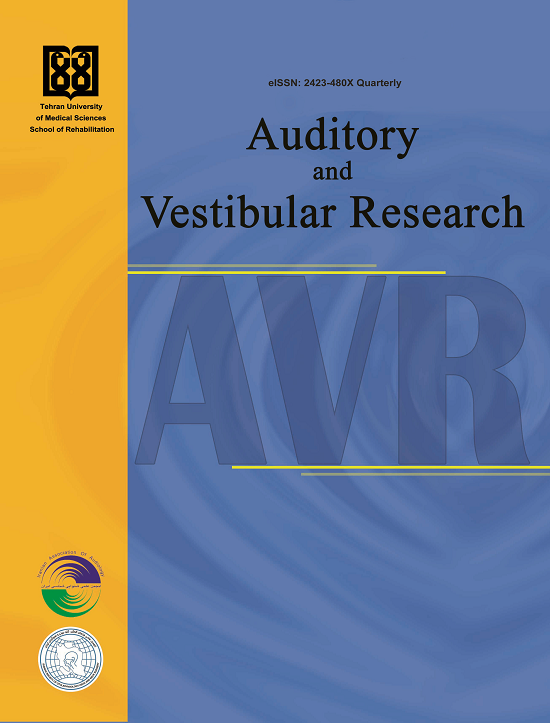Differential effects of temporal and spectral regularities on auditory streaming
Abstract
Background and aim:: The concept that recognizing sound regularities plays a major role in the segregation of auditory streams has lately gained significant interest. Thus, this study was designed to investigate how temporal and spectral regularities incorporated into the background auditory stream affect auditory stream segregation.
Methods: An indirect measure of auditory streaming task (i.e., detecting rare-level targets) was implemented in twenty-five healthy young adults. Participants were presented with two concurrent auditory streams involving foreground and background ones. Participants were instructed to detect rare-level targets in the foreground stream during three experimental conditions. These conditions vary based on the background auditory stream, which contained repeating temporal and spectral patterns alongside elements of randomness.
Results: Temporal and spectral regularities of the background auditory stream significantly increased the hit rate compared to random structure. Notably, this effect of regular cues on target detection and, possibly in turn, stream segregation was significantly greater for temporal compared to spectral regularities.
Conclusion: These findings showed that incorporating temporal or spectral regularities in the background auditory stream facilitated target detection and, possibly in turn, stream segregation. This perceptual regularity benefit was greater for temporal regularities than spectral regularities. These findings might present primary evidence for distinct facilitating effects of various theoretical frameworks of sound feature regularities on auditory streaming.
2. Alain C, Arnott SR. Selectively attending to auditory objects. Front Biosci. 2000; 5:D202-12. [DOI:10.2741/Alain]
3. Chakrabarty D, Elhilali M. A Gestalt inference model for auditory scene segregation. PLoS Comput Biol. 2019; 15(1):e1006711. [DOI:10.1371/journal.pcbi.1006711]
4. Snyder JS, Gregg MK, Weintraub DM. Attention, awareness, and the perception of auditory scenes. Front Psychol. 2012; 3:15. [DOI:10.3389/fpsyg.2012.00015]
5. Deike S, Denham SL, Sussman E. Probing auditory scene analysis. Front Neurosci. 2014; 8:293. [DOI:10.3389/fnins.2014.00293]
6. Paredes-Gallardo A, Innes-Brown H, Madsen SM, Dau T, Marozeau J. Auditory stream segregation and selective attention for cochlear implant listeners: Evidence from behavioral measures and event-related potentials. Front Neurosci. 2018; 12:581. [DOI:10.3389/fnins.2018.00581]
7. Gutschalk A, Micheyl Ch, Melcher JR, Rupp A, Scherg M, Oxenham AJ. Neuromagnetic correlates of streaming in human auditory cortex. J Neurosci. 2005; 25(22):5382-8. [DOI:10.1523/JNEUROSCI.0347-05.2005]
8. Xiang J, Simon J, Elhilali M. Competing streams at the cocktail party: Exploring the mechanisms of attention and temporal integration. J Neurosci.2010; 30(36):12084-93. [DOI:10.1523/JNEUROSCI.0827-10.2010]
9. Moore BC, Gockel H. Factors influencing sequential stream segregation. Acta Acustica United with Acust. 2002; 88(3):320-33.
10. Szalárdy O, Bőhm TM, Bendixen A, Winkler I. Event-related potential correlates of sound organization: Early sensory and late cognitive effects. Biol Psychol. 2013; 93(1):97-104. [DOI:10.1016/j.biopsycho.2013.01.015]
11. Denham SL, Gyimesi K. Perceptual bistability in auditory streaming: How much do stimulus features matter? Learn Percept. 2013; 5(Supplement 2):73-100. [DOI:10.1556/LP.5.2013.Suppl2.6]
12. Denham SL, Gyimesi K, Stefanics G, Winkler I. Stability of perceptual organisation in auditory streaming. In: Lopez-Poveda E, Palmer A, Meddis R, editors. The neurophysiological bases of auditory perception. New York: Springer; 2010. [DOI:10.1007/978-1-4419-5686-6_44]
13. Winkler I, Takegata R, Sussman E. Event-related brain potentials reveal multiple stages in the perceptual organization of sound. Brain Res Cogn Brain Res. 2005; 25(1):291-9. [DOI:10.1016/j.cogbrainres.2005.06.005.]
14. Bendixen A. Predictability effects in auditory scene analysis: A review. Front Neurosci. 2014; 8:60. [DOI:10.3389/fnins.2014.00060]
15. Bendixen A, Denham SL, Winkler I. Feature predictability flexibly supports auditory stream segregation or integration. Acta Acust united Acust. 2014; 100(5):888-99. [DOI:10.3813/AAA.918768]
16. Bendixen A, Bőhm TM, Szalárdy O, Mill R, Denham SL, Winkler I. Different roles of similarity and predictability in auditory stream segregation. Learn Percept. 2013; 5(Supplement 2):37-54. [DOI:10.1556/LP.5.2013.Suppl2.4]
17. Bendixen A, Denham SL, Winkler I. Sound predictability as a higher-order cue in auditory scene analysis. In: AIA-DAGA 2013 Conference on Acoustics, 18-21 March 2013, Merano, Italy. DOI ندارد
18. Bendixen A, Denham SL, Gyimesi K, Winkler I. Regular patterns stabilize auditory streams. J Acoust Soc Am. 2010. 128(6):3658-66. [DOI:10.1121/1.3500695]
19. Rimmele J, Schröger E, Bendixen A. Age-related changes in the use of regular patterns for auditory scene analysis. Hear Res. 2012; 289(1-2):98-107. [DOI:10.1016/j.heares.2012.04.006]
20. Andreou LV, Kashino M, Chait M. The role of temporal regularity in auditory segregation. Hear Res. 2011; 280(1-2):228-35. [DOI:10.1016/j.heares.2011.06.001]
21. Soltanparast S, Toufan R, Talebian S, Pourbakht A. Regularity of background auditory scene and selective attention: A brain oscillatory study. Neurosci Lett. 2022; 772:136465. [DOI:10.1016/j.neulet.2022.136465]
22. Sohoglu E, Chait M. Detecting and representing predictable structure during auditory scene analysis. Elife. 2016; 5:e19113. [DOI:10.7554/eLife.19113]
23. Barascud N, Pearce MT, Griffiths TD, Friston KJ, Chait M. Brain responses in humans reveal ideal observer-like sensitivity to complex acoustic patterns. Proc Natl Acad Sci U S A. 2016; 113(5):E616-25. [DOI:10.1073/pnas.1508523113]
24. Schwartze M, Farrugia N, Kotz SA. Dissociation of formal and temporal predictability in early auditory evoked potentials. Neuropsychologia. 2013; 51(2):320-5. [DOI:10.1016/j.neuropsychologia.2012.09.037]
25. Hughes G, Desantis A, Waszak F. Mechanisms of intentional binding and sensory attenuation: The role of temporal prediction, temporal control, identity prediction, and motor prediction. Psychol Bull. 2013; 139(1):133-51. [DOI:10.1037/a0028566]
26. Sperduti M, Tallon-Baudry C, Hugueville L, Pouthas V. Time is more than a sensory feature: Attending to duration triggers specific anticipatory activity. Cogn Neurosci. 2011; 2(1):11-8. [DOI:10.1080/17588928.2010.513433]
27. Shalgi S, Deouell LY. Direct evidence for differential roles of temporal and frontal components of auditory change detection. Neuropsychologia. 2007; 45(8):1878-88. [DOI:10.1016/j.neuropsychologia.2006.11.023]
28. Opitz B, Rinne T, Mecklinger A, von Cramon DY, Schröger E. Differential contribution of frontal and temporal cortices to auditory change detection: fMRI and ERP results. Neuroimage. 2002; 15(1):167-74. [DOI:10.1006/nimg.2001.0970]
| Files | ||
| Issue | Articles in Press | |
| Section | Research Article(s) | |
| Keywords | ||
| auditory scene analysis stream segregation temporal regularity spectral regularity regularity encoding | ||
| Rights and permissions | |

|
This work is licensed under a Creative Commons Attribution-NonCommercial 4.0 International License. |






